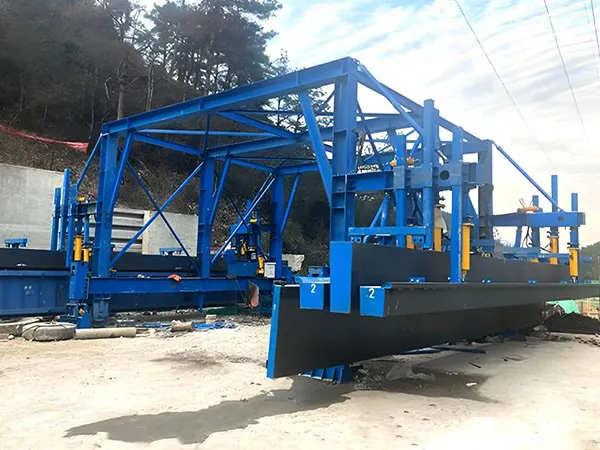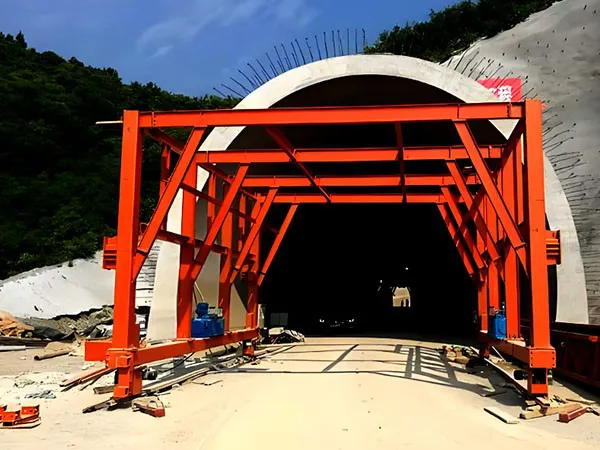Preventing concrete leakage in tunnel lining formwork is crucial for the structural integrity, durability, and aesthetics of the tunnel. Leakage can lead to honeycombing, voids, exposed rebar, and ultimately compromise the lining's performance.

Tight Joints: This is paramount. Formwork panels must be precisely manufactured and assembled to ensure minimal gaps.
Sealing Materials: Use appropriate sealing strips, gaskets, or expandable foam at all joints between formwork panels and at interfaces with existing structures.
Overlapping: Where possible, design formwork panels with overlapping sections to create a tighter seal.
Rigidity and Strength: The formwork must be strong enough to withstand the pressure of fresh concrete without deformation or deflection, which can create gaps.
Adequate Bracing and Support: Ensure the formwork is properly supported and braced to prevent movement during concrete placement and vibration.
Through-Ties and Wall Bolts: Use sufficient and correctly installed through-ties or wall bolts to secure the formwork. Ensure these penetrations are sealed effectively after removal.
Cleanliness and Release Agent:
Clean Surfaces: Before concrete pouring, thoroughly clean the formwork surfaces to remove any debris, dust, or hardened concrete that could prevent a tight seal.
Release Agent Application: Apply a suitable release agent evenly to the formwork surface. This facilitates easy stripping and helps prevent concrete from sticking to the formwork, which can damage the concrete surface and lead to leakage paths during subsequent pours.
Precision in Dimensions: The formwork should be manufactured to precise dimensions to ensure a snug fit and minimize gaps.
Concrete Mix Design:
Appropriate Slump: Use a concrete mix with the correct slump (workability) for tunnel lining. Too high a slump can lead to excessive bleeding and segregation, while too low a slump can make compaction difficult and increase the risk of voids.
Good Gradation: Ensure good aggregate gradation to minimize voids and improve concrete density.
Admixtures: Consider using admixtures like superplasticizers to improve workability and flow, and anti-washout admixtures in areas with potential water ingress.
Controlled Pouring:
Layered Placement: Pour concrete in controlled layers to prevent excessive pressure buildup on the formwork and ensure proper compaction.
Symmetrical Pouring: When lining an arch or curved section, pour symmetrically from both sides to the crown to maintain even pressure and prevent formwork displacement.
Controlled Pouring Speed: Regulate the pouring speed to allow for effective vibration and prevent segregation.
Direct Placement: Aim for direct placement of concrete into the formwork to minimize free fall height, which can cause segregation. Use tremie pipes or elephant trunks for deeper pours.
Effective Vibration:
Thorough and Even Vibration: Use internal vibrators to ensure thorough and even compaction of the concrete. This eliminates air voids (honeycombing) and ensures the concrete fills all corners and against the formwork.
Vibrator Placement and Movement: The vibrator should be inserted into the concrete not less than 50mm into the lower layer, and the moving distance should not be greater than 1.5 times its radius of action.
Avoid Over-Vibration: Over-vibration can lead to segregation and bleeding.
Avoid Contact with Formwork/Waterproofing: Do not directly contact the vibrator with the formwork or any waterproof membrane, as this can cause damage.
Monitoring and Inspection:
Continuous Monitoring: Continuously monitor the formwork for any signs of leakage during the concrete pour.
Real-time Adjustments: Be prepared to take immediate action if leakage occurs, such as tightening bolts, adding external bracing, or applying quick-setting mortar to small gaps.
Observation Holes: Some formwork systems include observation holes to check the concrete level and ensure complete filling.
Construction Joints: Where concrete pours are segmented, ensure proper preparation and sealing of construction joints to prevent future leakage. This may involve roughening the surface of the previous pour, cleaning it, and applying a bonding agent or waterstop.

Waterproof Membranes: Install a waterproofing membrane (e.g., PVC sheet membrane, spray-applied membrane) behind the concrete lining. This acts as a primary barrier against groundwater ingress.
Careful Installation: Ensure the membrane is installed meticulously, with all joints properly welded or sealed, and protected from damage during rebar and formwork installation.
Protection Layer: Apply a thin layer of shotcrete (30-50 mm) onto sprayed membranes before other works to protect them from damage.
Drainage Systems: Incorporate drainage systems (e.g., geotextile layers, drainage pipes) behind the membrane to manage any water that might bypass the membrane, preventing hydrostatic pressure buildup.
Proper Curing: Adequate curing of the concrete is essential to achieve its designed strength and durability, which contributes to its long-term resistance against leakage.
Early Demoulding Considerations: Control the demoulding time based on concrete strength tests to prevent damage to the concrete surface, which could lead to cracks and potential leakage.
By implementing these comprehensive measures, concrete leakage in tunnel lining formwork can be effectively prevented, ensuring a high-quality, durable, and structurally sound tunnel.
Gaofei
Address: 200m east of tulip garden, group 12 of zhangling community, hongshan street office, hongshan town, xigong district, Luoyang
Tel: +8616638856888
Contact: Gaofei Huang
Mobile: +86-18637923976
Phone: 0379-80881719/ 0379-60162687
QQ: 286827457
E-mail: gaofei@gf-bridge-tunnel.com